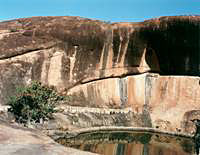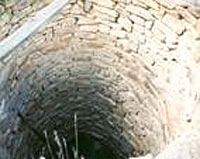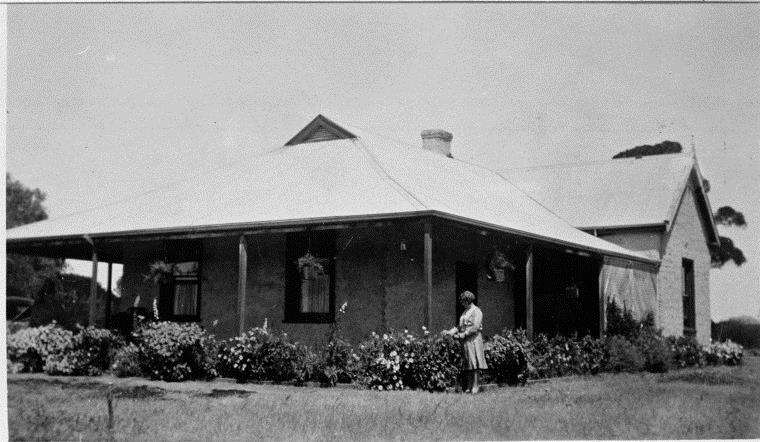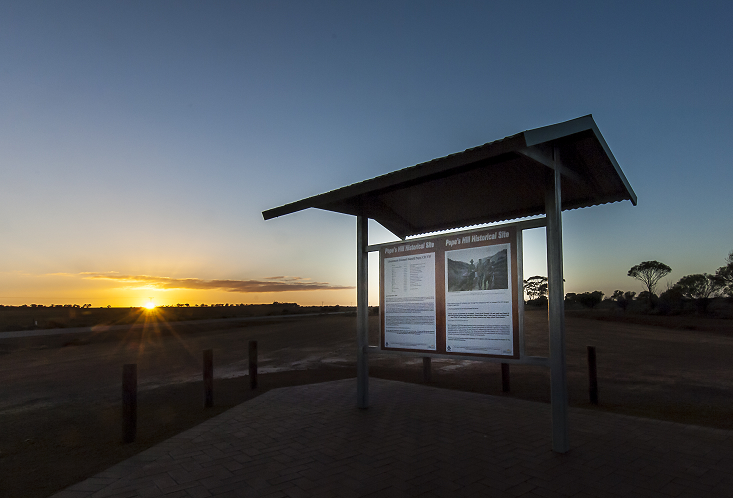Places of Interest
Beringbooding Rock
 Beringbooding Rock has the largest rock water catchment tank in Australia, built in 1937 and holding two and a quarter million gallons. “Sustenance Labour” was used to build the tank at a cost of 10,000 pounds. Beringbooding has an amazing balance boulder, a huge gnamma hole and some of the Kalamaia tribes paintings of hands in a cave at the rear of the rock. Two early pioneer wells are nearby. Spring finds the Pink Ti-tree, Heartshaped Leaf Eucalyptus Melaleuca, Acacia, Grevillea, hakea, Calothamnus, Eromophilia, Cassia, Quandongs, Sandalwood and the native Orchids flowering. Later into October and November the Kunzia Pulchella and One-sided Bottlebrush flower profusely. Many birds inhabit the area. Beringbooding Rock has great picnic and free camping facilities with easy caravan access, picnic tables, BBQ's, a toilet, interpretative signage and a marked walk trail.
Beringbooding Rock has the largest rock water catchment tank in Australia, built in 1937 and holding two and a quarter million gallons. “Sustenance Labour” was used to build the tank at a cost of 10,000 pounds. Beringbooding has an amazing balance boulder, a huge gnamma hole and some of the Kalamaia tribes paintings of hands in a cave at the rear of the rock. Two early pioneer wells are nearby. Spring finds the Pink Ti-tree, Heartshaped Leaf Eucalyptus Melaleuca, Acacia, Grevillea, hakea, Calothamnus, Eromophilia, Cassia, Quandongs, Sandalwood and the native Orchids flowering. Later into October and November the Kunzia Pulchella and One-sided Bottlebrush flower profusely. Many birds inhabit the area. Beringbooding Rock has great picnic and free camping facilities with easy caravan access, picnic tables, BBQ's, a toilet, interpretative signage and a marked walk trail.
Yanneymooning Hill
Yanneymooning Hill Reserve, 532 hectares of land situated on the corner of Echo Valley and Elachbutting Roads. The rock offers a spectacular view with a variety of bird life and flowers. The garden species ‘Silver Princess’ in its natural state can be found on top of the rock cascading into the valley below. Bottlebrush flowers in October/November. Cowslip and Patricia’s Spider Orchid along with many others can be found at the base of the rock in Spring.
Quanta Cutting Reserve
A granite outcrop with an interesting large circular gnamma hole. When flowering, the Kunzea Pulchella can be found in both the red and white varieties.
Weira Reserve
13 Kilometres east of Mukinbudin is the Weira Reserve. It boasts a picturesque limestone breakaway with a gnamma hole. There are barbecue, picnic and camping facilities including a toilet. Native flora and fauna abounds. Native orchids may be found on the bush trail and keep your eye out for the Red Capped Robin.
Wattoning Historical Site
 A significant historical settlement used for carting water at the turn of the century. Precious water was carted from a gnamma hole (water lifted by bucket tied to a rope), a soak and two wells constructed by early pastoralists, skilfully lined with rocks.
A significant historical settlement used for carting water at the turn of the century. Precious water was carted from a gnamma hole (water lifted by bucket tied to a rope), a soak and two wells constructed by early pastoralists, skilfully lined with rocks.
Three lonely graves of two babies and an earlier pioneer remind us of time gone by. A single Almond tree remains nearby the site of the original homestead.
Unique Bulk Grain Storage Silo
 Built in 1949 by the late Lloyd George (Jack) Jones. As the silo was progressively filled with grain, Mr Jones constructed the curved corrugated iron walls. He dug huge holes and trenches for the enormous timber main frame. Fashioned from the local bush with only an axe, he hoisted the poles up by using two 40KVA Chamberlain Kerosene tractors. The roof was constructed after the silo was filled. An early model tractor auger on a Fordson tractor was used to fill the silo.
Built in 1949 by the late Lloyd George (Jack) Jones. As the silo was progressively filled with grain, Mr Jones constructed the curved corrugated iron walls. He dug huge holes and trenches for the enormous timber main frame. Fashioned from the local bush with only an axe, he hoisted the poles up by using two 40KVA Chamberlain Kerosene tractors. The roof was constructed after the silo was filled. An early model tractor auger on a Fordson tractor was used to fill the silo.
The silo was originally located approximately 3 kilometres north of the Mukinbudin townsite and had fallen into disrepair due to summer storms and termites. With the aid of funding from Lotteries WA and Co-operative Bulk Handling along with much community support the Silo has been dismantled, restored and re-erected in Mukinbudin in recognition of the importance of the grain growing industry to this area and also the initiative and innovation of our pioneers.
Cleomine Horse
 Cleomine was farmed by George Lansdell, a prominent Perth bookmaker and racehorse owner. The property was called ‘Cleomine’ after Lansdell’s greatest horse, the 1920’s equal of Black Caviar. George Lansdell spelled his horses on this farm and many trainers, strappers and jockeys also came to Cleomine to train, work and rest.
Cleomine was farmed by George Lansdell, a prominent Perth bookmaker and racehorse owner. The property was called ‘Cleomine’ after Lansdell’s greatest horse, the 1920’s equal of Black Caviar. George Lansdell spelled his horses on this farm and many trainers, strappers and jockeys also came to Cleomine to train, work and rest.
The Cleomine Horse marks the spot where George built an impressive mudbrick five-roomed homestead, also adding a general store, butcher shop and blacksmith shop to serve the local settlers. He ran sheep, cattle and turkeys on his farm which supplied the butcher shop. The buildings were constructed from bricks manufactured and fired on site.
Pope's Hill Memorial

Situated 8kms east of the townsite, this site honours and tells the story of Colonel Harold Pope, John Mulqueeny and the returning soldiers who contributed greatly to the development of farming land in the Lake Brown area which was the first large-scale Soldier Settlement Scheme in Western Australia.
Drive-in Mural
The Mukinbudin Drive-In Opened in 1964, Located on North Road out of Town (across from Hutton & Northey). The drive-In closed in the early 1980’s The Mukinbudin Drive-Ins Reopened in October 1987 with “Crocodile Dundee” & “Footrot Flats – the Movie”, and was still operating in 2016. It was closed again in 2017.
Go Check out the Drive in Screen Mural of the lovely Pink and Grey Galahs!
Artwork done by James Giddy Artwork


